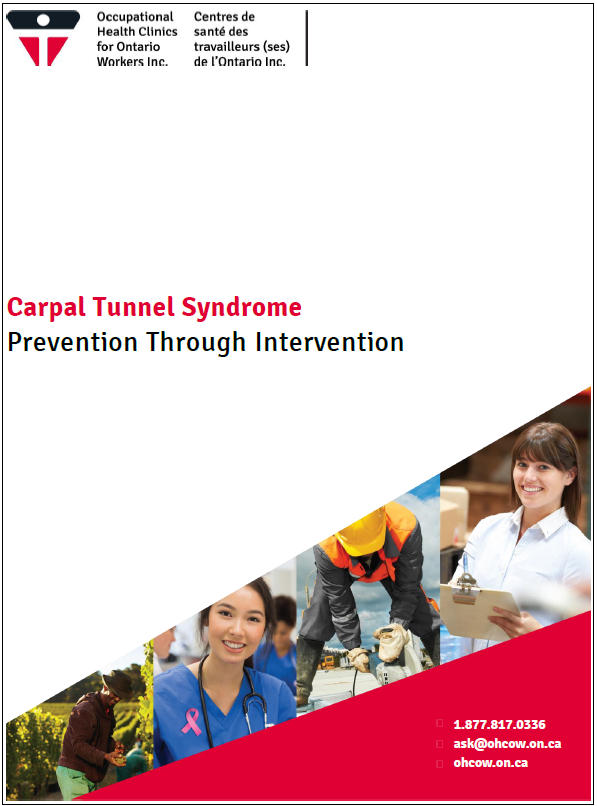TREATMENT
What Can Be Done for CTS?
Non-Surgical Treatment
Risk factors that are causing and aggravating your symptoms need to be changed or stopped if at all possible through workplace redesign or lifestyle changes.
Avoid the following whenever possible:
- repetitive hand motions,
- heavy grasping,
- holding onto vibrating tools, and
- positioning or working with your wrist bent down and out.
Have your workstation examined by a qualified Ergonomist. [See OHCOW Services]
Lifestyle habits such as smoking should be stopped.
Lose weight if you are overweight and reduce your caffeine intake.
A wrist brace will sometimes decrease the symptoms in the early stages of CTS by keeping the wrist in a resting (neutral) position - not bent back or bent down too far. When the wrist is in this position, the carpal tunnel is as large as it can be, so there is more room for the nerve inside the carpal tunnel. A brace can be helpful for easing the numbness and pain felt at night because it can keep your hand from curling under as you sleep. The wrist brace can also be worn during the day to calm symptoms and rest the tissues in the carpal tunnel.
Some health care professionals feel that it is not good to wear a brace while performing daily activities because they hold your own wrist up for you instead of the extensor muscles having to do it. Since the wrist brace is doing all the work in order to hold the wrist in the straight, neutral position, then the extensor muscles atrophy (wasting away) and become even weaker than they already were. The muscle imbalance between the flexors and extensor becomes even greater. Another major problem is that even though the wrist is still held straight, you can still use your fingers to perform repetitive or static flexion, such as typing, writing, etc., which again, will contribute to the muscle imbalance even more. Many feel that wrist braces and splints are more appropriate for night use in order to keep the wrist in the straight, neutral position. This is a key factor, because most people make a "fist" or "curl" their wrist into flexion while they sleep. Sleeping with the hands in this position causes the flexor muscle group to become even tighter and shorter; causing further impingement and damage to the carpal tunnel.
To help control the swelling of the tenosynovium, and reduce the symptoms of the carpal tunnel syndrome, anti-inflammatory medications may be suggested. These types of medications include ibuprofen and aspirin. In some studies, high doses of vitamin B-6 have been shown to help in decreasing CTS symptoms. If medications fail to relieve your symptoms, an injection of cortisone may be suggested. Cortisone may decrease the swelling of the tenosynovium, and may give temporary relief of symptoms. A new way has been discovered to get cortisone medication down the carpal tunnel. Iontophresis is a technique where an electrical current is used to move the molecules of medication through the skin down into the carpal tunnel.
If temporary relief is not obtained from the injection, it could indicate that some other problem is causing your symptoms. When your symptoms do go away after the injection, it is likely they are coming from a problem within the carpal tunnel. Some doctors feel this is a signal that a surgical release of the transverse carpal ligament would have a positive result.
Some types of exercises have also shown to help prevent or at least control the symptoms of CTS.
- Extend and stretch both wrists and fingers acutely as if they are in a hand-stand position.
- Hold for a count of 5.
- Straighten both wrists and relax fingers. Make a tight fist with both hands. Then bend both wrists down while keeping the fist. Hold for a count of 5
- Straighten both wrists and relax fingers, for a count of 5.
- Repeat exercise 10 times, then hang arms loosely at side and shake them for a couple of seconds. Total exercise time: 5-10 minutes.
Your doctor may suggest that you work with a physical or occupational therapist and contact an Ergonomist for a workplace inspection to redesign the work station [see OHCOW Services]. The main focus of treatment is to reduce or eliminate the cause of pressure in the carpal tunnel. The Ergonomist may check your workstation and the way you do your work tasks. Suggestions may be given about the use of body alignment and wrist positions, helpful exercises, and tips on how to prevent future problems such as workstation redesign. You might also receive treatments to reduce inflammation and encourage normal gliding of the tendons and median nerve within the carpal tunnel.
Surgical Treatment
Surgery may be suggested to reduce the pressure on the median nerve if conservative methods fail. Several different surgical procedures have been designed to relieve pressure on the median nerve. By releasing the pressure on the nerve, the blood supply to the nerve improves. If the nerve pressure has been going on too long, the median nerve may have thickened and scarred to the point that recovery after surgery is much slower and permanent damage may have occurred.
Open Release
The standard surgery for CTS is called “open release”. Open surgical procedures use a large skin incision. A sizeable incision is made down the front of the wrist and palm, usually about two inches long. By creating a large incision, the surgeon is able to clearly see the wrist structures to do the operation. The surgeon cuts the transverse carpal ligament in order to take pressure off the median nerve.
After dividing the transverse carpal ligament, the surgeon stitches the skin together and leaves the loose ends of the transverse carpal ligament separated. The loose ends are left apart to keep pressure off the median nerve. Eventually, the gap between the two ends of the ligament fills in with scar tissue.
Endoscopic Release
Another procedure is called endoscopic carpal tunnel release. The surgeon nicks the skin in order to make one or two small openings for insertion of the endoscope. An endoscope is a thin, fiber-optic TV camera that allows the surgeon to see inside the carpal tunnel as the transverse carpal ligament is carefully released.
Upon inserting the endoscope, the surgeon can see the wrist structures on a TV screen. A special knife is used to cut only the transverse carpal ligament. The palmar (palm) fascia and the skin over the wrist are not disturbed.
As in open release, the loose ends of the transverse carpal ligament are left apart after endoscopic release to keep pressure off the median nerve. The gap eventually fills in with scar tissue.


